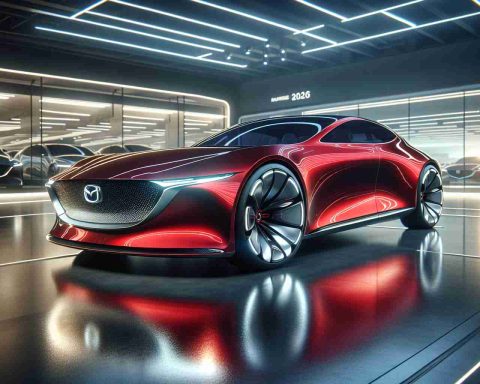- EV charging stations are central to creating a sustainable future, offering more than just car charging but also becoming community hubs and catalysts for change.
- These stations are evolving into modern meeting grounds, where people gather, exchange ideas, and create connections while promoting green technologies.
- Companies like Tesla are setting benchmarks with extensive, rapid charging networks that alleviate range anxiety and support long-distance travel.
- Integrating renewable energy, such as solar panels, enhances the sustainability of EV charging stations, reducing carbon footprints.
- Municipalities are incorporating EV chargers as essential infrastructure, enhancing urban spaces and fostering community connections.
- A cultural shift is needed to view these stations as beacons of sustainability, encouraging progress and environmental responsibility.
Electric vehicles are no longer a novelty on the road; they are paving the way to a sustainable future, buzzing along highways with the promise of cleaner air. Yet, the heart of this revolution beats most strongly at an unexpected place: the EV charging station.
Picture this: early mornings as city streets awaken, workers rush to their jobs, and amidst this hustle, EV charging stations quietly hum with activity. Not just functional, these charging hubs are transforming how we view our urban landscapes. Amid the scent of fresh coffee and the soft glow of smartphone screens, people gather—no longer to fuel their cars with fossil resources but to recharge and reconnect.
Many overlook the hidden potential of these stations. Beyond charging cars, they are emerging as community focal points and catalysts for change. Imagine a station not just as a plug-in point, but as a modern meeting ground where ideas spark over freshly brewed espressos. Entrepreneurs, innovators, and commuters mingle, sharing not just electricity, but knowledge, dreams, and aspirations.
This evolution is propelled by companies expanding EV infrastructure. Tesla’s Supercharger network, for instance, has set a gold standard by offering rapid charging solutions, covering vast areas and making long journeys feasible without range anxiety. According to the International Energy Agency, the number of publicly accessible chargers increased by 45% in 2022, showcasing an unwavering commitment to green transport.
Yet, the vision extends further. Integrating renewable energy sources like solar panels transforms these stations into green energy powerhouses. As sunlight dances upon sleek panels, electric cars charge using the very power of the sun, embodying pure sustainability. Such innovations not only reduce carbon footprints but also inspire a generation to prioritize the planet.
Moreover, municipalities are realizing the transformative power of EV chargers. Urban planners are weaving them into city fabric as essential infrastructure, akin to public transport. These stations breathe life into underserved areas, bridging gaps and connecting communities.
Embracing the potential of EV charging stations requires more than technology—it demands a cultural shift. Society must recognize them as beacons of a sustainable future, illuminating the path to progress. In a world frantically seeking answers to environmental challenges, EV charging stations shine as a bright, hopeful signpost.
In essence, EV charging stations are redefining the journey itself. They are not just endpoints or starting points but revitalize the spaces in between. As the world races forward, these stations remain steadfast, quietly powering the future and empowering a generation to drive change.
Takeaway: EV charging stations are more than just stops on a journey; they are dynamic hubs of innovation, sustainability, and community connection, driving us toward a greener tomorrow.
Electric Vehicle Charging Stations: The Unsung Heroes of the Green Revolution
Deeper Insights into the Evolution of EV Charging Stations
Electric vehicles (EVs) have rapidly shifted from niche to mainstream, drawing significant attention to the infrastructure supporting them: the EV charging station. As more cities and countries set ambitious electric mobility targets, charging stations have become pivotal in shaping urban landscapes and environmental futures. Here’s a detailed look at aspects often overshadowed in the broader EV conversation:
How-To Steps and Life Hacks for EV Owners
1. Optimize Charging Time: Utilize apps like ChargePoint or PlugShare to find available chargers during non-peak hours, reducing wait times.
2. Route Planning: Use tools integrated into EVs, like Tesla’s Trip Planner, to ensure seamless travel by pinpointing convenient charging stops.
3. Understanding Different Chargers: Familiarize yourself with Level 1, Level 2, and Level 3 (DC Fast Charging) stations. Level 1 is the slowest, ideal for overnight, while Level 3 is best for quick top-ups during travel.
Real-World Use Cases and Benefits
– Community Hubs: In urban areas, charging stations evolve into community hubs, supporting local businesses by encouraging foot traffic.
– Workplace Charging: Companies installing stations can increase employee satisfaction and align with corporate sustainability goals.
– Tourism Boost: Locations with accessible charging options attract more EV tourists, stimulating local economies.
Market Forecasts and Industry Trends
– Exponential Growth: According to a report by Allied Market Research, the global EV charging station market is expected to reach $72 billion by 2027.
– Technological Advances: Expect to see more stations integrated with IoT devices for better energy management and enhanced user experience.
– Renewable Integration: Solar-powered stations will become commonplace, reducing operational costs and environmental impact.
Features, Specs, and Pricing
– Charging Speeds: Fast chargers can replenish up to 80% of an EV’s battery in 30 minutes, crucial for long-distance travel.
– Cost: Charging costs vary by region and provider, but generally range from $0.10 to $0.30 per kWh.
Security and Sustainability
– Cybersecurity Measures: As part of smart grid networks, charging stations employ robust security protocols to protect user data.
– Sustainability Initiatives: Stations using solar panels and battery storage systems minimize reliance on the grid, showcasing a full-cycle green solution.
Pros & Cons Overview
– Pros:
– Encourages adoption of EVs by alleviating range anxiety.
– Supports environmental sustainability and reduces fossil fuel dependency.
– Cons:
– Infrastructure still developing in rural areas.
– Initial setup costs can be high, although they decrease over time with advances in technology.
Common Questions and Pressing Concerns
1. How long does it take to charge my EV?
Charging time varies by charger type and EV model. Level 1 can take up to 20 hours, while Level 3 takes under an hour for a significant charge.
2. Are there enough EV charging stations available?
Yes, but availability is concentrated in urban areas. Expansion efforts are ongoing to improve accessibility in rural locations.
3. What are the costs associated with public charging?
Costs depend on the network and local electricity rates. Membership plans can offer savings for frequent users.
Actionable Recommendations
– Install a home charger: Maximizes convenience and reduces reliance on public stations.
– Stay informed: Keep abreast of local incentive programs for EVs and charging infrastructure.
– Network and Share: Utilize social platforms to share best practices and tips for efficient charging.
For more information on the future of electric vehicles and charging networks, visit the International Energy Agency and Tesla.

















